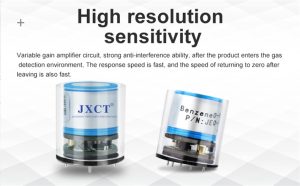-
Construction of gas sensor
- Gas sensors play a crucial role in various industries and applications, from monitoring air quality to ensuring safety in hazardous environments. These sensors detect the presence and concentration of specific gases in the environment. Th……
- Chat Online
-
Description
Gas sensors play a crucial role in various industries and applications, from monitoring air quality to ensuring safety in hazardous environments. These sensors detect the presence and concentration of specific gases in the environment. The construction and design of gas sensors are essential factors that determine their sensitivity, selectivity, and reliability. In this article, we will explore the construction of gas sensors, focusing on the different components and technologies used in their design.

1. Sensing Element
The sensing element is the heart of a gas sensor and is responsible for detecting the target gas. There are different types of sensing elements used in gas sensors, including metal oxide semiconductors (MOS), electrochemical cells, photoionization detectors (PID), and catalytic bead sensors.
a) Metal Oxide Semiconductors (MOS):
MOS gas sensors are widely used due to their low cost, small size, and high sensitivity. They consist of a sensing material, typically a metal oxide, deposited on a substrate. The gas molecules interact with the sensing material, causing changes in its electrical resistance. This change in resistance is measured and correlated to the gas concentration.
b) Electrochemical Cells:
Electrochemical gas sensors are based on the principle of redox reactions. They consist of electrodes immersed in an electrolyte, with a gas-permeable membrane separating the electrodes from the gas environment. The target gas reacts at the sensing electrode, resulting in a current flow that is proportional to the gas concentration.
c) Photoionization Detectors (PID):
PID gas sensors utilize ultraviolet (UV) light to ionize gas molecules. The ionization process generates a measurable current or charge, which is proportional to the gas concentration. PID sensors are commonly used for detecting volatile organic compounds (VOCs) and are highly sensitive.
d) Catalytic Bead Sensors:
Catalytic bead sensors are specifically designed to detect combustible gases. They consist of two platinum wire coils coated with a catalyst, typically palladium. When the target gas comes into contact with the catalyst, it undergoes combustion, resulting in a change in temperature and resistance. The resistance change is measured and used to determine the gas concentration.
2. Transducer
The transducer is responsible for converting the physical or chemical changes detected by the sensing element into an electrical signal. The type of transducer used depends on the sensing element and the measurement technique employed.
a) Resistive Transducers:
Resistive transducers are commonly used with metal oxide semiconductor (MOS) gas sensors. They measure the change in electrical resistance of the sensing material and convert it into a voltage or current output.
b) Potentiometric Transducers:
Potentiometric transducers are used with electrochemical gas sensors. They measure the potential difference between the sensing and reference electrodes and convert it into a measurable signal.
c) Capacitive Transducers:
Capacitive transducers are utilized in some gas sensors, particularly those based on MOS technology. They measure the change in capacitance caused by the adsorption or desorption of gas molecules on the sensing material.
d) Optical Transducers:
Optical transducers are employed in some gas sensors, such as photoionization detectors (PID). They measure the current or charge generated by the ionization of gas molecules by UV light.
3. Enclosure and Packaging
The enclosure and packaging of gas sensors are critical for their protection and proper functioning. The enclosure should provide a hermetic seal to prevent the ingress of moisture, dust, and other contaminants that can affect the performance of the sensor. The packaging should also allow for proper diffusion of the target gas to the sensing element while protecting it from direct contact with external substances.
Additionally, the enclosure may include a protective filter to block interfering gases or particles from reaching the sensing element. The filter should be carefully selected to ensure it does not hinder the diffusion of the target gas.

4. Electronics and Signal Processing
Gas sensors are typically integrated with electronics and signal processing circuits to convert the analog signals from the transducer into a digital format and provide output for data acquisition and analysis. The electronics may include amplifiers, analog-to-digital converters, microcontrollers, and communication interfaces.
The signal processing circuits are designed to filter noise, linearize the sensor response, and compensate for environmental factors such as temperature and humidity. This ensures accurate and reliable gas concentration measurements.
Conclusion
The construction of gas sensors involves the careful selection and integration of various components. The sensing element, transducer, enclosure, and electronics all contribute to the sensitivity, selectivity, and reliability of the sensor. The choice of construction materials, manufacturing techniques, and quality control processes are also crucial for ensuring consistent and accurate gas detection. By understanding the construction of gas sensors, we can appreciate the complexity and engineering behind these vital devices that help us maintain safety, monitor air quality, and facilitate various industrial processes.
-
Recommend:
-
-
Gas sensors play a crucial role in various industries and a…
-
Three characteristics of gas sensor
Gas sensors are devices used to detect the presence …
-
Next generation gas detection for industrial refrigeration
Industrial refrigeration systems play a critical role in pr…
-
What is a wall-mounted O2 gas detector?
A wall-mounted O2 gas detector is a device used to m…
-
 : +86 155 8830 2704
: +86 155 8830 2704 : jxdziot@gmail.com
: jxdziot@gmail.com
